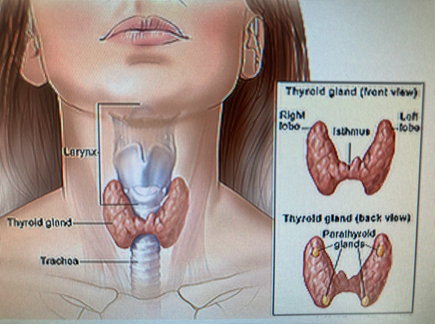Know the thyroid
1. It's anatomy is shown on the following picture :
Derived from the Greek word « thyreoeides » meaning shield, the thyroid doesn`t protect anything. It`s a butterfly-shaped organ located on our neck, consisting of two lobes attached by a band called the isthmus. The thyroid is attached to the trachea, this is why it`s mobile when we swallow. Two nerves pass in its posterior part: recurrent nerves or inferior laryngeal nerves. They are responsible for the mobility of vocal cords, for our voice. 2 parathyroid glands are generally found on the back side of each thyroid lobe. Their number can vary. Parathyroid glands are responsible for calcium regulation.
2. Its functioning
The thyroid functioning is difficult but its regulation is easy to understand.
The thyroid gland secretes hormones (Т4 and Т3) into the bloodstream. Then, the hormones get to the aim, different organs of human body such as heart, muscles and brain, to ensure their correct functioning.
The thyroid hormones regulate metabolism (in other words a correct use of energy) which helps to keep up a correct human body temperature.
The thyroid in its turn is controlled by the hormone produced by the pituitary gland, TSH (thyroid-stimulating hormone).
The pituitary gland has extremely sensible receptors of the level of thyroxine (T4) in the blood. The pituitary gland regulates how much hormones the thyroid releases.
If the TSH level is within normal limits, the thyroid functions normally. It`s in a condition called euthyroidism (what we frequently see in case of thyroid cancer).
In case of excessive thyroid hormone production, the TSH is low – it`s a state of hyperthyroidism.
The underactive thyroid will make the pituitary gland to produce more TSH, so TSH level will be high. It`s a condition called hypothyroidism.
Following the link below you will find a video « how does the thyroid gland work? » -
